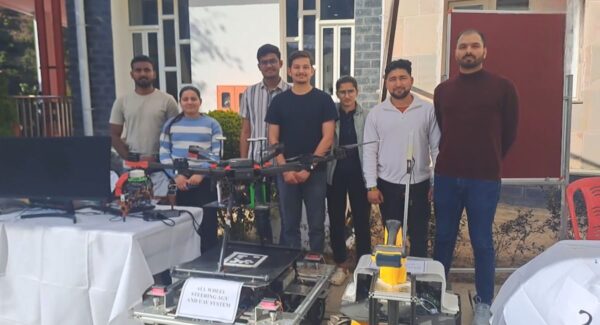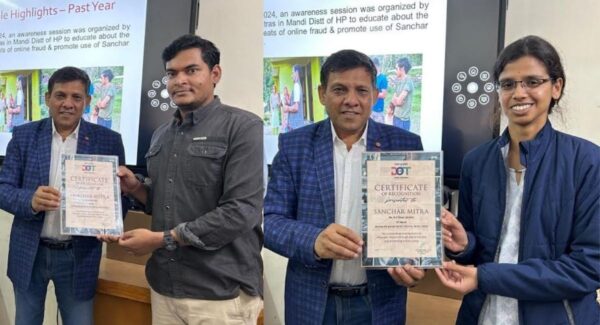News
IIT Mandi Develops Fish-Inspired Marine Vehicle to Predict Sea Cyclones

Mandi, March 19, 2025:
In a groundbreaking achievement, the Indian Institute of Technology (IIT) Mandi, in collaboration with IIT Palakkad, has developed an innovative marine vehicle designed to collect crucial data from the depths of the sea. This state-of-the-art vehicle, which resembles a fish, will play a key role in gathering data that could significantly enhance the prediction of future sea cyclones. While it won’t directly forecast these natural disasters, the data it collects will help scientists understand oceanic conditions and trends, potentially providing valuable insights into cyclone behavior.
The project, dubbed the Hybrid Propulsion Underwater Robotic Vehicle (HPURV), was developed under the leadership of Assistant Professor Jagdish from IIT Mandi, with collaboration from Professor Shantu Kumar Mohan at IIT Palakkad. This breakthrough marks a significant step in marine research, as such a vehicle has never been developed in India before, making it a pioneering effort within the country’s scientific community.
A Unique Design with Dual Propulsion System
The Hybrid Propulsion Underwater Robotic Vehicle is an advanced underwater vehicle designed to function like a fish. Its design and propulsion system allow it to navigate the depths of the ocean with greater agility and efficiency compared to traditional marine vehicles. Professor Jagdish explained that the vehicle combines multiple propulsion mechanisms, making it more versatile and capable of operating in challenging underwater environments. This design is a significant improvement over previous models, and IIT Mandi’s unique approach places India at the forefront of marine robotics research.
Unlike conventional marine vehicles, which are typically bulky and cumbersome, the HPURV’s fish-like shape and propulsion system allow it to move with ease and mimic the natural movement of marine life. The vehicle is designed for a variety of functions, with an emphasis on long-term underwater research, especially in gathering data related to ocean currents, water temperature, salinity, and other vital oceanographic parameters.
Deep Sea Exploration with Advanced Capabilities
The Hybrid Propulsion Underwater Robotic Vehicle has the capability to dive to depths of up to 100 meters, where it can stay submerged for four to five hours. This depth and duration allow it to gather vital ocean data that would otherwise be difficult or impossible to obtain. According to Professor Jagdish, the current version of the vehicle is still undergoing testing and refinement, but it has already proven its potential for underwater data collection.
Looking ahead, the team at IIT Mandi is working on enhancing the vehicle’s capabilities. The goal is to extend its depth range to over 1,000 meters and increase its endurance to a week or more underwater. This will allow the vehicle to provide continuous data on ocean conditions, which will be crucial for monitoring environmental changes that could lead to cyclonic activity in the future.
Impact on Cyclone Prediction and Disaster Management
The data gathered by the HPURV will not provide direct predictions of sea cyclones, but it will be an essential tool in understanding the underlying conditions that influence cyclone formation. By studying the oceanographic data collected by the vehicle, scientists can better assess the factors contributing to the development of cyclones, such as temperature changes, pressure shifts, and ocean current patterns.
In regions like the Indian Ocean, which is prone to frequent cyclones, this data could prove invaluable in improving early warning systems and disaster preparedness. By analyzing the conditions under which cyclones are more likely to form, researchers can help mitigate the devastating effects of such storms, saving lives and reducing property damage.
Make in India Initiative and Future Prospects
One of the standout features of this project is that it was developed entirely under the Make in India initiative. This project showcases India’s growing capabilities in advanced technology development, particularly in the field of marine science and robotics. As part of the Make in India initiative, the HPURV is entirely designed, developed, and fabricated in India, which reflects the country’s increasing focus on self-reliance in high-tech industries.
The collaboration between IIT Mandi and IIT Palakkad represents a significant step forward for Indian research institutions in developing cutting-edge technologies that can benefit both the country and the global scientific community. As the project progresses, there are hopes that similar innovations will continue to emerge from Indian institutions, helping to address the challenges posed by natural disasters and climate change.
A Step Towards Sustainable Marine Research
The development of the Hybrid Propulsion Underwater Robotic Vehicle marks a significant leap in the field of marine research. By enabling long-duration underwater data collection and providing valuable insights into oceanographic conditions, the HPURV will contribute to a deeper understanding of the ocean environment. As the technology evolves, it is expected that this fish-like vehicle will be a key tool in addressing environmental challenges and advancing ocean research, both in India and globally.



